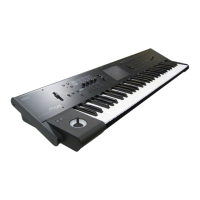Appendices
390
Expression will be set to the maximum value (127).
*4 A value of 64 will correspond to the value specified by
the program parameter. 0 is the minimum, and 127 is the
maximum. Changing from 63–1 or from 65–126 will
adjust the effect from the program parameter setting
toward the minimum value or maximum value.
• For details about the specific parameters controlled by
these CCs, please see “Parameters controlled by MIDI
CCs #70-79” on page 390.
*5 Controlled on the global MIDI channel.
*6 Corresponds to the operation of the VALUE slider as a
controller when you’ve selected Prog P0 Program Select
or Combi P0 Combination Select.
*7 If you assign a CC# to the ARP ON/OFF switch,
arpeggio control knobs 1–4, or chord trigger switches 1–
4, and perform these operations on the M50, the assigned
CC# will be transmitted, and the M50 itself will also be
controlled at the same time. If this message is received,
the result will be the same as if the M50 itself had been
operated.
The CC# settings for each knob and switch are made in
the Global P2– MIDI CC# Assign page. Use these settings
if you need to assign control change messages, for exam-
ple when you want to record switch operations on the
internal sequencer or an external MIDI sequencer, or to
control the arpeggiator from an external MIDI device.
Each knob and switch can be assigned to any desired
MIDI control change message CC#00–119, but normally
you will choose the Global P2– MIDI CC# Assign menu
command Reset Controller MIDI Assign and use the
CC Default settings.
This table shows the operations for the CC Default set-
tings. The CC Default settings are the CC#s recom-
mended for use with these controllers. Normally, you
will assign these CC#s.
Parameters controlled by MIDI
CCs #70-79
CC#70–79 correspond to the M50’s program parameters
listed below.
In Program mode, the corresponding program parameters
will be temporarily edited when CC#70–79 messages are
received on the global MIDI channel (MIDI Channel Global
1–1a), when knobs 1–4 are operated when the control
surface is in Realtime Control A mode, or when knobs 1–4
are operated when assigned to CC#70–79 with the control
surface in Realtime Control B mode.
In most cases, you can use the Write Program menu
command to save the edited values, over-writing the
previous Program settings.
In Combination and Sequencer modes, you can use
these CCs to temporarily edit the parameters for all
Timbres or Tracks on a given MIDI channel. However,
edits made in this way cannot be saved back into a
Program.
CC#Internal parameters controlled by the CC
70 (Sustain level)
Filter EG 1/2 Sustain (see page 37)
Amp EG 1/2 Sustain (see page 45)
71 (Filter resonance) Filter A/B, 1/2 Resonance (see page 31)
72 (Release time)
Filter EG 1/2 Release (see page 37)
Amp EG 1/2 Release (see page 45)
73 (Attack time)
EG Times:
Filter EG 1/2 Attack (see page 37)
Amp EG 1/2 Attack (see page 45)
Amp EG 1/2 Time Modulation: Attack (see page 46)
EG Levels:
Amp EG 1/2 Level Start (see page 45)
Amp EG 1/2 Level Attack (see page 45)
Amp EG 1/2 Level Modulation: Start (see page 46)
74 (Filter cutoff frequency) Filter A/B, 1/2 Frequency (see page 31)
75 (Decay time)
Filter EG 1/2 Decay (see page 38)
Filter EG 1/2 Slope (see page 38)
Amp EG 1/2 Decay (see page 45)
Amp EG 1/2 Slope (see page 45)
76 (LFO1 speed) LFO 1 Frequency (see page 48)
77 (LFO1 Pitch intensity) Pitch LFO1 Intensity (see page 25)
78 (LFO1 delay) LFO 1 Delay (see page 49)
79 (Filter EG intensity)
Filter EG 1/2 Intensity to A (see page 35)
Filter EG 1/2 Intensity to B (see page 35)

